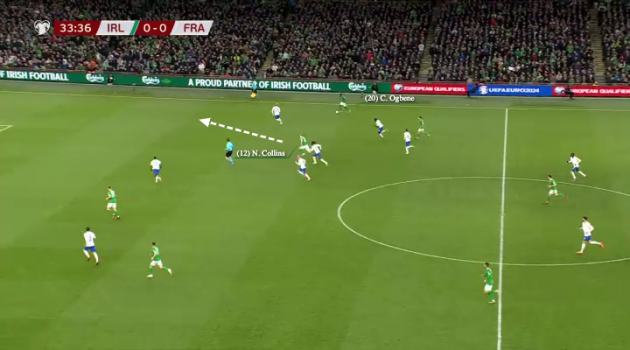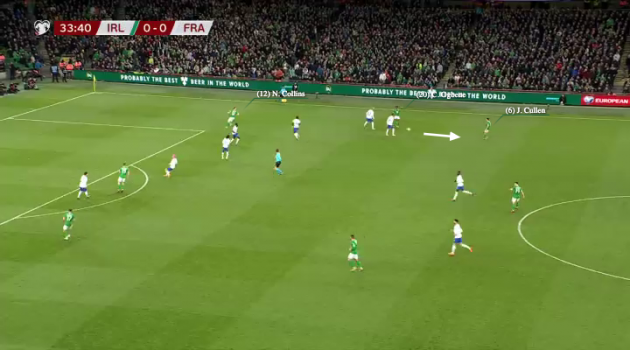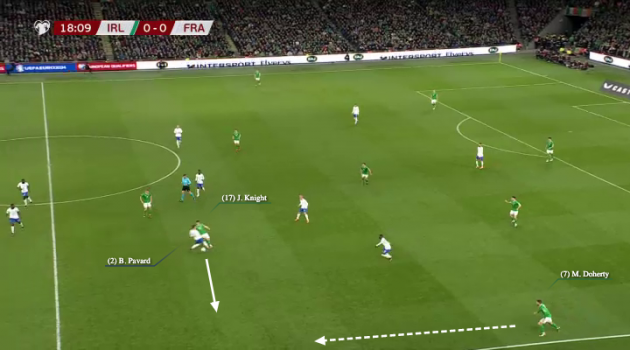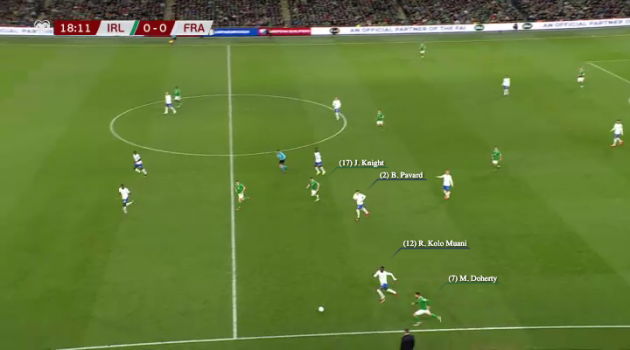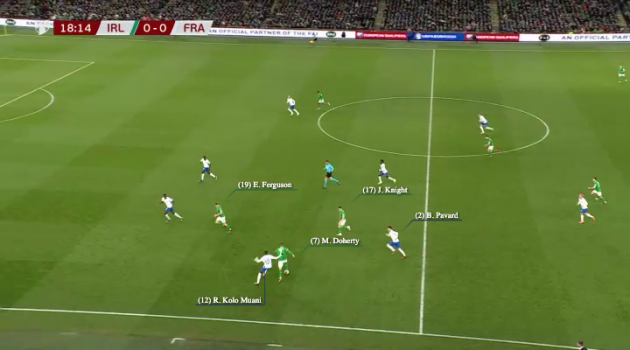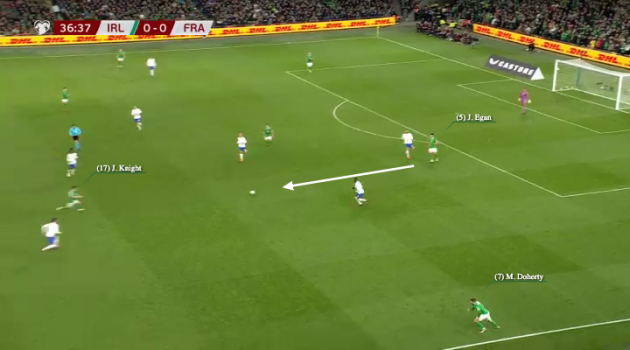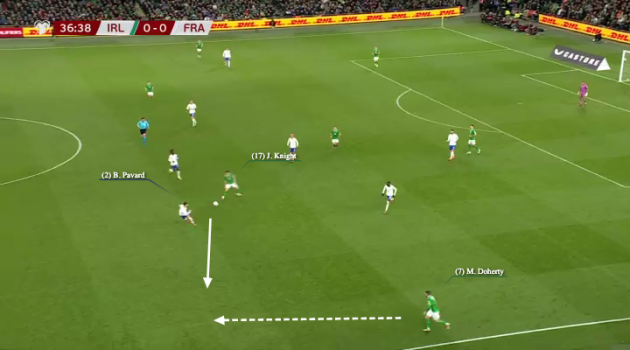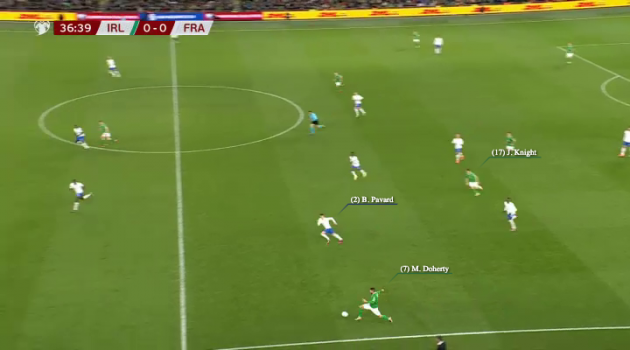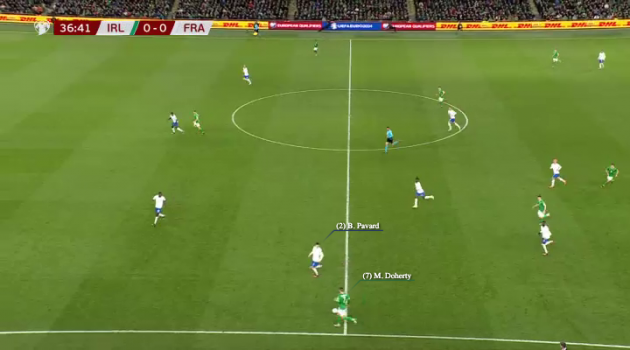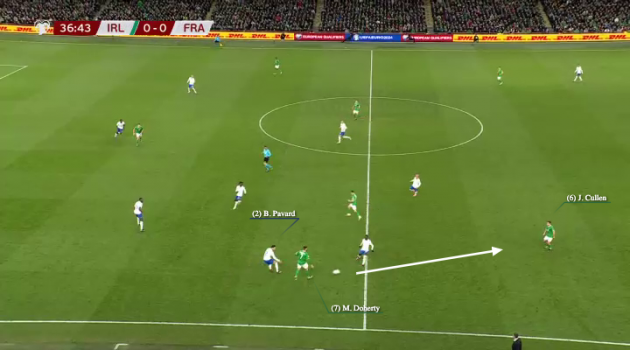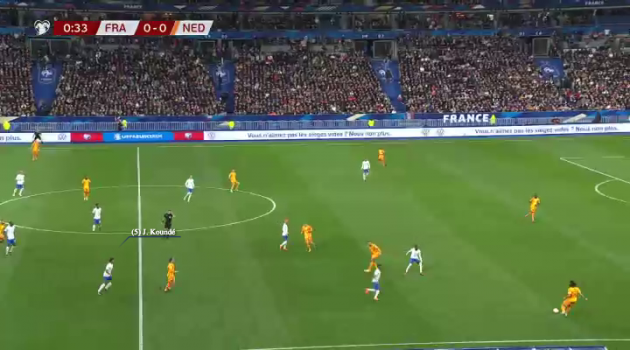ANOTHER HARD LUCK story for Ireland then, this time left to rue one sloppy error, one now-trademark opposition screamer, and one “out of this world” save from the opposition goalkeeper.
Ireland were disciplined and diligent and canny and brave and unlucky against France… but they weren’t perfect.
And, ultimately, they needed to be perfect.
The chasm between the manager’s pre-game rhetoric and reality was stark. Stephen Kenny said that Ireland would not take a step back against France but any visions of this manifesting in a kind of wide-open, freewheeling gameplan did not survive contact with reality.
Instead Ireland set up in a 5-4-1 out of possession, with Chiedozie Ogbene dropping in as a very effective and diligent right wing-back to allow Seamus Coleman concentrate his energies on Kylian Mbappe.
Mbappe finished the game without a shot on target and France had 10 shots in total, with three of them on target. Since the last edition of the Nations League, only England in the World Cup quarter-final have managed to keep France to so few shots. Okay, Ireland were ultimately beaten by a shot from range – we will get to that – but overall their plan to stifle France worked extremely well.
France have at least one world class player in every position and the team has no issues with either individual attitude of collective cohesion, so they are too good to be completely shut out. Defending them is really an exercise in mitigation, and Ireland should be proud of their efforts in this regard.
Limiting France meant Ireland had to temper some of their attacking instincts and their guiding principle until the final few minutes was, in Kenny’s pre-game words, “to counter the counter-attack.”
France, with Mbappe’s terrifying pace, are set up to kill teams on the counter. They don’t hog the ball – they averaged 51% possession at the World Cup, only the 13th-highest at the tournament – but instead are happy to sit off teams, invite them into traps and then spring forward on the counter.
Ireland didn’t have to look far for an example of this. They merely had to make it two minutes into the tape of Friday’s clash between France and the Netherlands.
𝐆𝐑𝐈𝐄𝐙𝐌𝐀𝐍𝐍! 🇫🇷
— Virgin Media Sport (@VMSportIE) March 24, 2023
No captaincy? No problem!
And guess who provided the assist!?#EURO2024 pic.twitter.com/Wvij9MOF0y
Ireland attacked knowing that Mbappe offered a near-existential risk over their shoulders. Hence they dialled down their risk in build-up play. Here is one example of many from the first-half: Nathan Collins surges forward and then runs off the French defence, but Ogbene hardly looks at him, instead recycling possession.
Pep Guardiola’s belief at Barcelona was that an attack could only truly begin once his side has strung together 15 passes, as at that point everyone would be in the correct position to snuff out any potential counter attacks. Ireland were nowhere near that dogmatic last night, but they did lean on the idea.
But the key facet to last night’s set-up was that Ireland did not set up only to defend. Just as they did away to Portugal in Faro in 2021, Ireland had very clear patters for counter-attacking.
One of them was obvious: hit Ogbene down the right-hand side. In Faro they targeted Aaron Connolly’s pace behind Joao Cancelo, whereas last night they used Ogbene to attack Theo Hernandez’ wing.
It brought Ireland most of their best moments. Ogbene won a couple of cheap free-kicks out of nothing in the first-half and then most of Ireland’s second-half attacks came down his side.
Coleman was brilliant all night but the one slight wrinkle in his performance were a couple of skewed balls up the touchline for Ogbene in the first-half. His distribution was much better after half-time. Hernandez, meanwhile, struggled against Ogbene, and how he escaped a booking remains a mystery. There was a lot more to Ogbene’s game last night than pace, but it is true to say his speed terrified Hernandez and constantly offered Ireland a way up the pitch.
But Stephen Kenny may quietly lament the lack of pace on Ireland’s left wing.
In a huddle with journalists after the win over Latvia, Kenny praised Callum O’Dowda’s performance, but they were words clearly filtered through the plan for the French game.
“He has just been injured for a lot of my time as manager but he could play at a good level. He’s the quickest player that we have in that position by some distance. We have good players that can counter attack but he’s rapid and we’ll need that against France – we need speed, that’s important.”
And so typically O’Dowda picked up a groin strain and missed the game entirely. His absence was costly.
Matt Doherty played at left wing-back instead and he played well. Defensively he was very good, faced with a very difficult opponent in Randal Kolo Muani. But, through no fault of his own, Doherty doesn’t have O’Dowda’s acceleration and neither is he left-footed, which blunted Ireland’s counter-attacking abilities down the left flank.
Ireland showed a good ability to play through French pressure. This was a typical manoeuvre: Knight drops off to take a zipped O’Shea pass, and then pops the ball out wide left for Doherty.
Doherty is a little too deep here and doesn’t quite have the pace to burst beyond Kolo Muani and into the space vacated by Benjamin Pavard, who has been attracted to Knight.
Credit to Doherty, though: he holds off the challenge of Kolo Muani, and, naturally for a right-footed player, comes inside and wins a free-kick.
Later in the half, Ireland tried the same exit move again. This time it’s John Egan’s pass, and again Knight does well to attract Pavard and then spin the ball wide for Doherty.
Doherty takes the ball on the run but then checks back slightly, allowing Pavard to recover, and eventually Doherty plays the ball backwards to Cullen to retain possession.
Again these are small moments, but they were instances when Ireland could have made more of an attacking impact and isolated the French centre-backs. Knight’s smart link-up play prised an opening in the French press, and it is tempting to wonder if Ireland would have made the most of them if O’Dowda – a faster, direct runner – had been available. O’Dowda is also left-footed, meaning he would have much less of a temptation to cut in-field onto his right.
That’s not to say Doherty didn’t get forward – one excellent run saw Doherty beat two players before his pull-back for Ferguson was intercepted by the brilliant Konate – and it is also doubtful that O’Dowda would have defended Kolo Muani – soon to be a €100 million forward – as well as Doherty did. But Ireland lacked the pace down the left-wing to force France into a slight retreat and, in a game of such fine margins, that made all the difference.
One line from Kenny’s post-game press conference stuck out.
“France had watched us and they knew we would be tough opponents, they paid us respect and pressed us extremely high, in the first half especially.”
So France didn’t sit off Ireland as they have done in previous games. It’s not true to say they pressed Ireland in every part of the field to the same extent: they were too wary of Ogbene’s pace to go full-court down Ireland’s right-side.
But Benjamin Pavard led a high press of Ireland’s left-hand side: he stuck to Knight in midfield and wasn’t afraid to go beyond him to chase the ball.
Take this moment in which Pavard wins a throw-in off O’Shea for instance…
…and contrast it to Jules Kounde’s position when the Dutch left-back, Nathan Ake, had the ball on Friday night.
But France could afford to allow Pavard press really high as Ireland just didn’t have enough pace to exploit the space he left behind him. And even if they did, France were confident in Ibrahima Konate’s ability to defend the wide spaces outside of him, given he does exactly that for Liverpool every week. (Or at least for every week he’s fit.)
But it is an alluring, maddening question: if Ireland had more pace on their left flank, would Pavard have been quite as high, and quite as bold?
It’s maddening, because Ireland were ultimately undone by Pavard’s high pressing.
The idea from Josh Cullen is good. He has Jason Knight and Doherty breaking to his left for a counter-attack, and playing the pass was consistent with Ireland’s approach, which was to defend diligently but use the ball with care. But unfortunately the pass is bad, or, to be more accurate, is made to look bad by how high and proactive Pavard was.
Pavard steals in to win the ball and then wins the game with a stunning strike.
⚽ GOAL
— RTÉ Soccer (@RTEsoccer) March 27, 2023
🇮🇪 0-1 🇫🇷
Ireland give the ball away on the edge of their own box and Pavard smashes a shot in off the crossbar
📺 Watch @RTE2 and @RTEPlayer https://t.co/2W5kFtUgZE
📱 Updates: https://t.co/MQPj9kO4Lu
📻 Listen: @GameOn2fm#IRLFRA #EURO2024 pic.twitter.com/I7DxYmaVdU
It goes to show how strategy in international football hinges on defining and deciding on acceptable risk. Ireland did that brilliantly in their preparations and then throughout the game, but sadly, so did France.
And ultimately their exceptional individual quality decided the game.
Ireland did what they had to do and made the game one of small margins.
But sadly those margins swung against them, yet again.

